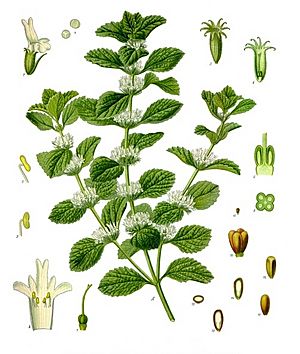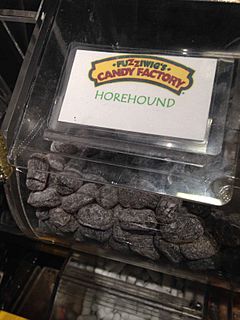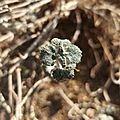White horehound facts for kids
Quick facts for kids White horehound |
|
|---|---|
 |
|
| Marrubium vulgare | |
| Scientific classification |
Marrubium vulgare, also known as white horehound or common horehound, is a type of flowering plant. It belongs to the mint family, called Lamiaceae. This plant originally comes from Europe, northern Africa, and parts of Asia.
White horehound can now be found in many other places around the world. It grows naturally in most of North and South America. It is a herb with grey leaves that lives for many years (perennial plant). It usually grows to be about 25 to 45 centimeters (10 to 18 inches) tall. Its leaves are 2 to 5 centimeters (0.8 to 2 inches) long and feel crinkly. They are also covered in soft, downy hairs. The plant has small white flowers that grow in groups along the top part of its main stem.
Contents
What Does "Horehound" Mean?
The name "horehound" comes from old English words. "Hoar" meant "white" or "light-colored," like the white frost you see on a cold morning (hoarfrost). "Hune" was an old word for certain types of herbs or plants. Over time, people changed the second part of the word to sound more familiar.
How People Use White Horehound
Horehound in Medicine
People have talked about using white horehound as a medicine for a very long time. It was mentioned over 2,000 years ago! A Roman writer named Aulus Cornelius Celsus wrote about it helping with breathing problems in his book De Medicina. Another Roman writer, Columella, said it could help farm animals get rid of worms.
For centuries, many herbal books have mentioned horehound for similar uses. However, even with all this history, there is no strong scientific proof today that white horehound works as a medicine. The U.S. Food and Drug Administration (FDA) does not say it is a medicine. But they do say it is safe to use as a food additive.
Horehound as Food
You might have heard of horehound candy drops. These are hard candies, a bit like cough drops. They are made with sugar and a special liquid taken from the white horehound plant. These candies are dark and have a slightly bitter taste. Some people say they taste like menthol or root beer. Just like the plant itself, these candies are sometimes used as a traditional home remedy for coughs. But remember, there's no scientific proof they work as medicine.
White horehound is also used to make different drinks. These include horehound beer, which is similar to root beer. It can also be made into a herbal tea, much like the mint tea popular in North Africa. Sometimes, it's even an ingredient in a drink called a rock and rye cocktail.
White Horehound as a Weed
In the 1800s, white horehound was brought to southern Australia because people thought it was a useful medicinal herb. But it started to spread very quickly. It became a noxious weed in native grasslands and pastures. This happened because it was carried by the livestock (farm animals) that settlers brought with them. Now, it has spread as much as it can in Australia.
In New Zealand, people are working to stop its spread. They use a method called biocontrol. This means they use natural enemies of the plant to control it. For example, the horehound clearwing moth (Chamaesphecia mysiniformis) and the horehound plume moth (Wheeleria spilodactylus) eat the plant. This helps to reduce the number of horehound plants.
White horehound often grows in areas that have been disturbed or where animals have eaten too much grass. Farm animals usually do not like to eat horehound. So, they eat other plants around it, which allows the horehound to grow and spread even more. It can also stay alive in natural areas that have been grazed by animals.
White Horehound as Biocontrol
Interestingly, Marrubium vulgare can also be used in a good way to control pests. It acts as a natural repellent against grasshoppers in farming.
Gallery
See also
 In Spanish: Marrubium vulgare para niños
In Spanish: Marrubium vulgare para niños








